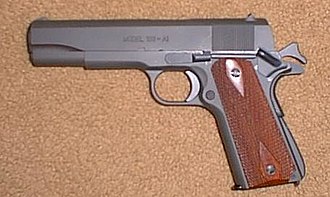Parkerizing

Parkerizing is a method of protecting a steel surface from corrosion and increasing its resistance to wear through the application of a chemical phosphate conversion coating. It was usually applied to firearms. [5] : 393 Parkerizing is usually considered to be an improved zinc or manganese phosphating process, and not to be an improved iron phosphating process, although some use the term parkerizing as a generic term for applying phosphating (or phosphatizing) coatings that do include the iron phosphating process.
Bonderizing, phosphating, and phosphatizing are other terms associated with the Parkerizing process but were often used for finishes of car parts as it gave finer grain on the surface. [5] : 394 It has also been known as pickling in the context of wrought iron and steel. [11]
Parkerizing is commonly used on firearms as a more effective alternative to bluing, which is an earlier-developed chemical conversion coating. It is also used extensively on automobiles to protect unfinished metal parts from corrosion.
The Parkerizing process cannot be used to protect non-ferrous metals such as aluminium, brass, or copper but can be used for chemical polishing or etching instead. It similarly cannot be applied to steels containing a large amount of nickel, or on stainless steel. Passivation can be used for protecting other metals.
Early history
Development of the process was started in Britain and continued by the Parker family in the United States. The terms Parkerizing, Parkerize, and Parkerized are all registered U.S. trademarks of Henkel Adhesives Technologies, although the terminology has largely passed into generic use for many years. The process was first used on a large scale in the manufacture of firearms for the United States military during World War II. [12]
The earliest work on phosphating processes was developed by British inventors William Alexander Ross, British patent 3119, in 1869, and by Thomas Watts Coslett, British patent 8667, in 1906. Coslett, of Birmingham, England, subsequently filed a patent based on this same process in America in 1907, which was granted U.S. patent 870,937 in 1907. It essentially provided an iron phosphating process, using phosphoric acid.
An improved patent application for manganese phosphating based in large part on this early British iron phosphating process was filed in the US in 1912, and issued in 1913 to Frank Rupert Granville Richards as U.S. patent 1,069,903 .
Clark W. Parker acquired the rights to Coslett's and Richards' U.S. patents, and experimented in the family kitchen with these and other rust-resisting formulations. The ultimate result was that Parker, along with his son Wyman C. Parker, working together, set up the Parker Rust-Proof Phosphating Company of America in 1915.
R. D. Colquhoun of the Parker Rust-Proof Phosphating Company of America then filed another improved phosphating patent application in 1919. This patent was issued in 1919 as U.S. patent 1,311,319 , for an improved manganese phosphating (Parkerizing) technique.
Similarly, Baker and Dingman of the Parker Rust-Proof Company filed an improved manganese phosphating (Parkerizing) process patent in 1928 that reduced the processing time to 1⁄3 of the original time that had been required through heating the solution to a temperature in the precisely controlled range of 500 to 550 °F (260 to 288 °C). This patent was issued as U.S. patent 1,761,186 in 1930.
Manganese phosphating, even with these process improvements, still required the use of expensive and difficult-to-obtain manganese compounds. Subsequently, an alternative technique was developed by the Parker Company to use easier-to-obtain compounds at less expense through using zinc phosphating in place of manganese phosphating. The patent for this zinc phosphating process (using strategic compounds that would remain available in America during a war) was granted to inventor Romig of the American Chemical Paint Company in 1938 as U.S. patent 2,132,883 , just prior to the loss of easy access to manganese compounds that occurred during World War II.
Somewhat analogous to the improved manganese phosphating process improvements discovered by Baker and Dingman, a similarly improved method was found for an improved zinc phosphating process as well. This improvement was discovered by Darsey of the Parker Rust Proof Company, who filed a patent in February 1941, which was granted in August 1942, U.S. patent 2,293,716 , that improved upon the zinc phosphatizing (Parkerizing) process further. He discovered that adding copper reduced the acidity requirement over what had been required, and that also adding a chlorate to the nitrates that were already used would additionally permit running the process at a much lower temperature in the range of 115 to 130 °F (46 to 54 °C), reducing the cost of running the process further. With these process improvements, the end result was that a low-temperature (energy-efficient) zinc phosphating (Parkerizing) process, using strategic materials to which the United States had ready access, became the most common phosphating process used during World War II to protect American war materials such as firearms and planes from rust and corrosion.
Later developments

Glock Ges.m.b.H., an Austrian firearms manufacturer, uses a black Parkerizing process as a topcoat to a Tenifer process to protect the slides of the pistols they manufacture. After applying the Tenifer process, a black Parkerized finish is applied and the slide is protected even if the Parkerized finish were to wear off. Used this way, Parkerizing is thus becoming a protective and decorative finishing technique that is used over other underlying improved techniques of metal protection.
Various of similar recipes for stovetop kitchen Parkerizing circulate in gun publications at times, and Parkerizing kits are sold by major gun-parts distributors such as Brownells.